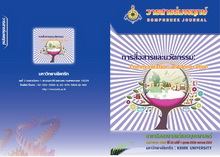การสื่อสารเพื่อสร้างการมีส่วนร่วมของชุมชนในการอนุรักษ์น้ำคลองแสนแสบ : ชุมชนมัสยิดกมาลุลอิสลาม กรุงเทพมหานคร
Main Article Content
Abstract
The Use of Communication to Create People Participation in Water Conservation at Khlong Saen Saep : Masjid Kamal-Ul-Islam Community, Bangkok
The objective of this research on “Communication to Create Community Participation in Water Conservation at Khlong Saen Saep: Masjid Kamal-Ul-Islam Community” is to study the community communication, the leadership role in participation, creation, participation level, and community members’ communication network on water conservation at Khlong Saen Saep. The researcher applied two qualitative research methods including documentary research and in-depth interviews of 19 experts in water conservation at Khlong Saen Saep.
The findings of the research indicated that the communication between the groups of community leaders which were consisted of Imams, Masjid committee, community committee and the seniors in the community with the villager groups was in the mode of two-way communication, top-down flow of communication, informal communication, and cooperative communication emphasis through personal media more than commanding. The communication between villagers and villagers was in the mode of three hundred and sixty degree communication, horizontal flow of information with multiplicity, and deliberative communication emphasis. In addition, the villagers also had the mode of communications through different activities, personal media, broadcast media by wired broadcasting system, television media, on-line social network or face-to-face conversation. The messages created for use in communication were classified into two perspectives including : 1) cleanness perspective based on Islam principle mentioned in Al-Quran that the cleanness is a part of devotion and water is the core that Muslims must utilize for washing body to be clean before appearing in front of god through the Salat times, the worship of the Allah’s kindness for five times per day; and 2) benefit perspective mutually gained by all levels of community members from the water conservation at Khlong Saen Saep. The roles of the leaders in communication to create participation were as the communicator of knowledge, change agent and teacher. The community members of Masjid Kamal Ul-Islam participated in water conservation at Khlong Saen Saep in three levels consisting of 1) Decision-Making Level, 2) Cooperation Level, and 3) Utilization Level. Moreover, the characteristics of the community media networks included 1) teacher group having the type of decentralized communication network, and 2) industrial factory group having the type of centralized communication network.
Article Details
Every article published in the Romphruek Journal of the Humanities and Social Sciences is the opinion and point of view of the authors. Thery're not the viewpoint of Krirk University or the editored department. Any part or all of the articles for pablication must be clearly cited.


